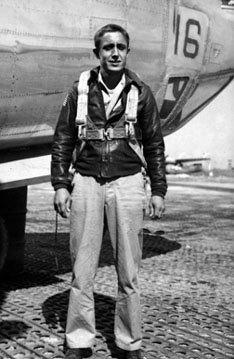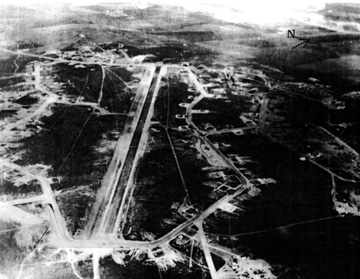|
Story of WW II Shoot Down and POW Experiences |
||||||||||
 |
 |
|||||||||
|
Crew Introduction to the Combat Arena At Mitchel Field we were processed for overseas assignment. We received our shots and update of our medical records. We were issued complete flying gear and whatever items of our uniforms that needed replacement. |
||||||||||
 |
 |
|||||||||
|
Above: Checking out our |
||||||||||
|
Since two of our crew lived in New York City, they directed us to the party sites for these last days in the USA. The bombardier’s family had us over to their house one evening for a luncheon. Dick Weisner and his navy brother-in-law were our guides on our downtown tour of New York City. Then on August 6, 1944 we loaded our gear aboard our assigned B-24 aircraft, very early, and were off on the first leg of our flight to Bangor, Maine. A short flight, but it gave us a chance to check out the brand new aircraft with extra fuel tanks in the Bombay. Our stay was just overnight, the weather was clear the next morning and off we went to St. Johns, Newfoundland, our next stop. This was a much longer flight landing in clear weather in the late afternoon. At St. Johns we checked the plane over very closely as the next flight would be about ten hours over water to the Azores Islands. After a two or three day wait, we left St. Johns before sunup on the morning of our departure for the Azores Islands in the Atlantic Ocean. Flying independently, with each crew navigator setting the flight direction, we came to the island on-course and on-time about sundown.
We immediately refueled the aircraft for early takeoff the next morning as the weather was to be clear for the next leg of our trip. We left early in the morning on the next leg over water to Marrakech, Morocco, North Africa. This was about a seven hour flight and we were back over land again. We had to stand guard over our plane all the time we were there, so usually two or more of us stayed with the aircraft. Again we checked the aircraft and fuel to be ready for takeoff when cleared to do so. The next stop was Tunis, a short flight, arriving early afternoon. We established our guard system on the aircraft the same as before now that we were nearing our combat zone. We spent a full day there, then left the next morning for the staging area in Italy. When we crossed the Mediterranean Sea we noted a large flotilla heading north along the coast. After we landed we found this to be the southern invasion of France. This staging area was somewhere in southern Italy where we would receive our group and squadron assignment. The staging area was a large base and the aircraft were scattered around the airfield. The parking ramp where we were assigned was on the road to a small village that was having a church celebration, so we had a lot of traffic by our aircraft. Marty, of Italian background, would talk to these people as they traveled to and from town. The next day they were giving vino (wine) as a gift to us, but needed their bottles back. When the first canteens were full of wine we began to fill the five gallon water cans. After a time it was hard to find a drink of water. In this waiting time the skipper, Jim Moye, with the help of all of us, painted the insignia on the aircraft that we had flown into the combat area. The slogan was “Nine Hits and a Mississippian”. This was because nine of us were northern born and Jim was from Laurel, Mississippi. We arrived in Italy about 15 August 1944, and when the assignments came we were assigned to the 451st Bomb Group (H), 727th Bombardment Squadron, located at Castelluccio Air Base, Italy. We suddenly lost our aircraft that we had hopes of flying in combat to another organization that was short of aircraft. A crew from our newly assigned unit came in and picked us up. |
||||||||||
| At Castelluccio Air Base, the squadron location was a tent city scattered over the area. The mess hall was an old barn with a hard floor. The cooks had fixed it up quite well. The squadron ground crew personnel had fixed the shower and latrine area, etc., up real well as they had been on location well before we were assigned there for duty and scheduled for our first flight into combat. | ||||||||||
 |
||||||||||
|
be still further below picture limit. |
||||||||||
|
The 15th Air Force was our overall command and they had established a policy that each crew was required to complete 50 missions to complete their tour of combat missions.
End of Chapter 3 Go to Cover — Introduction — Table of Contents Chapter — 1 — 2 — 3 — 4 — 5 — 6 — 7 — 8 — 9 — 10 — 11 — 12 — 13 Or Go To Home - Contact Us - Cold War Hist. - 91st SRS Hist. - Stardust 40 Mission Story |
||||||||||